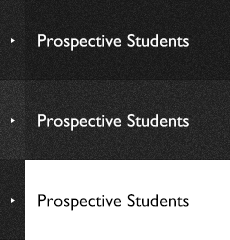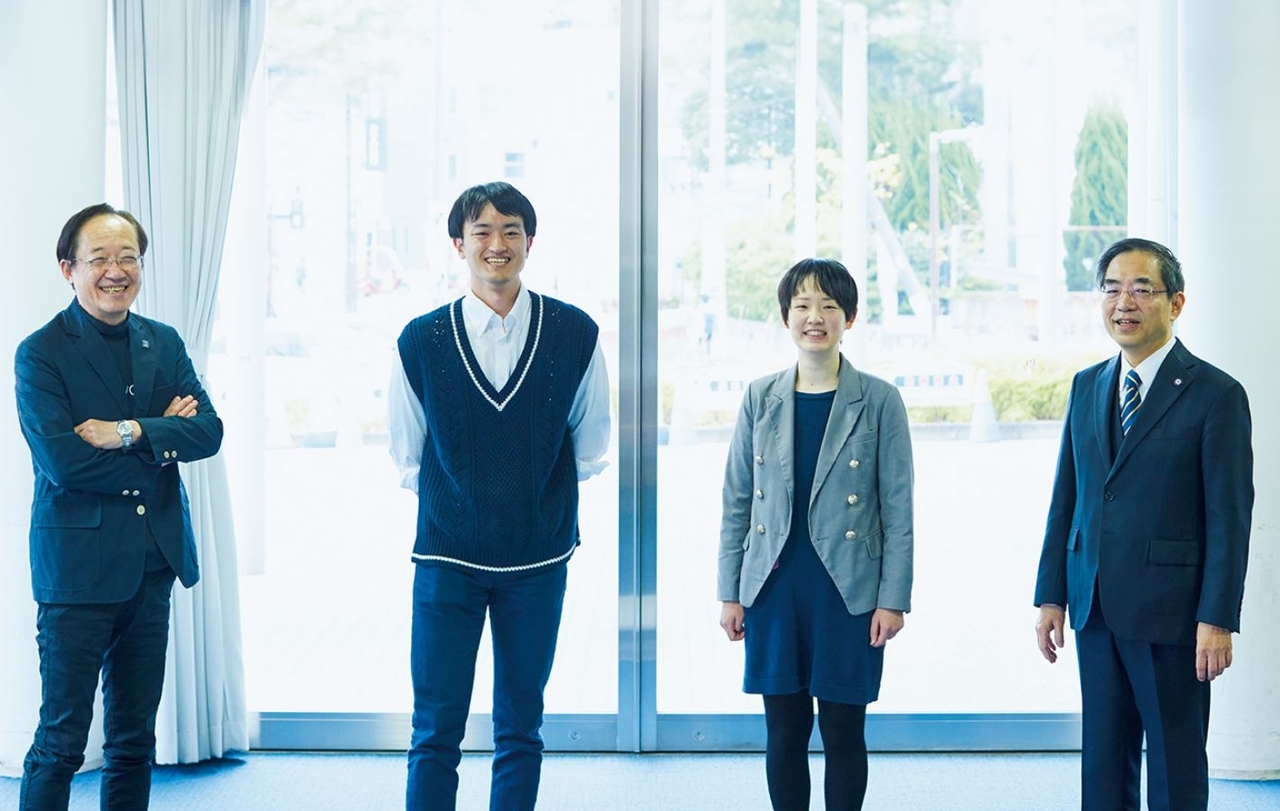
Kazuya Masu
President, Tokyo Institute of Technology
Yudai Yamazaki
Tokyo Institute of Technology
Sakura Kirino
Tokyo Medical and Dental University
Yujiro Tanaka
President, Tokyo Medical and Dental University
Tokyo Institute of Technology (Tokyo Tech) and Tokyo Medical and Dental University (TMDU) will merge in October 2024 to become Institute of Science Tokyo. Both universities have amassed numerous achievements and knowledge in the fields of science and engineering and medical and dental sciences. To get a glimpse of this cutting-edge research, we held a round-table discussion with both presidents on research by students from both universities. From student presentations to discussions to suggestions by both presidents, we report on this stimulating dialogue.
Presentation 1: The next generation of ultra-high-speed semiconductors and wireless devices
Yudai Yamazaki, 1st year doctoral student, Department of Electrical and Electronic Engineering, School of Engineering, Tokyo Tech
Unlock a future which no one has yet achieved
I conduct research on transceivers for next-generation wireless communications such as 5G and 6G. A typical example of a wireless device is a smartphone, but the frequencies used for its communications are microwaves, which are primarily frequencies below 6 GHz. Faster wireless communication will be needed for a variety of applications in the future, and current microwave frequencies are already being used by many people and are becoming increasingly strained. This has led to the idea that we should look to higher frequencies, which has become a trend in next-generation wireless communications research.

"Millimeter-wave band phased array transceiver" for use in the millimeter-wave band (28 to 100 GHz). It gives directionality to signals and enables long-distance communications, raising hopes for high-speed wireless communication.
You may not have a good idea of what I mean by frequency, but I am researching circuits related to high frequencies with an eye to the future. They are called "millimeter waves" and range from 30 GHz to roughly 100 GHz. The value of the research is that the use of higher frequencies will allow for increasingly fast wireless communications. If we disregard the effects of other factors and calculate only with frequency, we believe that using frequencies 5 to 10 times higher than microwaves will increase the data rate of wireless communication by a factor of 5 to 10, thereby increasing what is feasible.
We heard from two people from TMDU, who explained the potential of the technology in medical care. One of the things 5G communication makes possible is telemedicine. If a patient is in a rural area and there is no physician in the area, there may be instances where an online medical interview is conducted using web conferencing. But the treatment that can be done is limited because the image quality in web conferencing tools is not high. The use of higher frequencies (millimeter waves) in 5G communications will enable faster wireless communications and expand the types of treatments that can be performed in remote locations. For example, remote robotic surgery in which a doctor in Tokyo moves his hand, and a robotic arm located in the rural area moves in the same way. Although direct palpation is not possible, if next-generation wireless communication is achieved, it will be possible to transmit the feeling of touching a patient's body to the doctor through a robotic arm.
If there is a turning point in my research, it may very well be right now. When I went on to the doctoral program, I started to take on new research challenges. I mentioned millimeter waves earlier, and the next step is to advance from there to sub-terahertz wireless communications research. This may sound unfamiliar, but if millimeter waves are between 30 and 100 GHz, sub-terahertz waves are above 100 GHz. I mentioned earlier that millimeter waves are 5 to 10 times faster than today's speeds, but sub-terahertz waves can reportedly achieve speeds 10 to 50 times faster.
What I am currently struggling with is that I have to start from scratch because it is new research field. I had previously been studying millimeter waves with a frequency of about 30 GHz. At that frequency, I had a lot of prototypes and experimental data amassed by my senior colleagues in the laboratory, and I was able to create high precision circuits based on these. Going forward, I will be taking on a completely different frequency, so there is no precedent, and I will have to build up everything myself from scratch. To build a circuit, I first need basic data such as the high-frequency characteristics of transistors, and I am working hard on my own starting with building that design environment. I am also making the wireless communication circuitry to be installed on top of that, which brings home how challenging this venture is.
As for my future prospects, I would like to further expand the scope of my research through the merger with TMDU. My specialization is wireless device circuits, but since all my friends around me are also involved in technology, I still feel that my own horizons are a bit narrow. However, the new university will allow me to interact with people from the completely unfamiliar fields of medicine and dentistry. As with this session, I expect that by visiting each other's laboratories and communicating with each other, we will be able to deepen our insights and further apply them to our own research.
Discussion
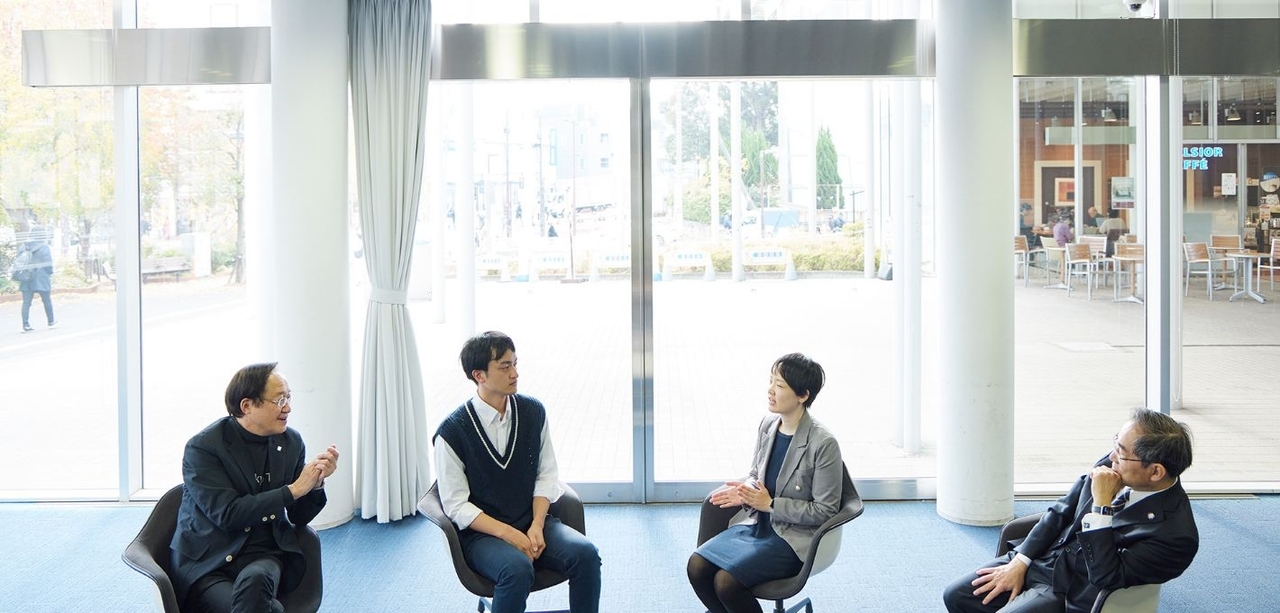
Kirino:I was glad to hear your presentation. I learned that information technology has been and will continue to make the world a better place. Considering its combination with my own specialization, there seems to be a strong compatibility with the robotic surgery that Mr. Yamazaki mentioned. We can also transmit Japanese medical care to other countries. Robotic surgery will become better the more it is performed, and the level of medical care will continue to improve, which is very appealing.
Yamazaki:That's interesting. I am also interested in robotic surgery, and I believe that this is exactly where my research can be applied. By the way, is it possible to use wireless communication in the operating room? I have heard that smart phones cannot be used because some devices are sensitive to radio waves.
Tanaka:That is not necessarily the case today. I sometimes talk to doctors in the operating room on my smartphone.
Yamazaki:Oh, I see! I believe that the operating room is an ideal environment for using high-data-rate communications. The reason is that the higher the frequency, the shorter the distance it can travel. At frequencies above 100 GHz, no matter how hard you try, you can only reach 100 to 200 meters. Although there is a future vision of setting up poles every 100 meters, at the initial stage I thought that we should aim to use high frequencies in the confines of a room that requires high-data-rate communication, and I envisioned the operating room as a place well-suited to high frequencies. Hearing President Tanaka say that wireless communication is available in the operating room is very encouraging.
Tanaka:With a distance of about 100 meters, it would be useful in a disaster. In the event of a disaster, cables are not available, but there would be many patients within a 100 meter radius. I believe that's exactly the situation in the Gaza Strip in Palestine right now. In that situation, one doctor can see many patients at once without traveling much. It seemed the ideal method in a situation where neither the patient nor the doctor can move.
Presentation 2: Identifying the origin of regenerative stem cells and regenerative mechanisms in the intestinal epithelium
Sakura Kirino, 2nd year of Doctoral Course, Gastroenterology, Graduate School of Medical and Dental Sciences, TMDU
Studying cellular mechanisms with patients in mind
I am studying the cellular mechanisms related to the regeneration of the intestinal epithelium. In recent years, inflammatory bowel diseases such as ulcerative colitis and Crohn's disease have been on the rise, and I am studying what happens to cells as a result of inflammation and how the intestinal epithelium regenerates.
In a healthy state, the intestinal epithelium turns over, cell shedding and regeneration in a short cycle of about three days, and the cycle of new epithelium and shedding of the old one is progressively repeated. It is estimated that about 7% of human stools are shredded intestinal epithelium. However, if the inflammation is too strong, the normal turnover mechanism is disrupted and new epithelium cannot be produced. This is a critical situation for cells, and it has become clear in recent years that various regeneration mechanisms are at work in the body to somehow remedy the situation.
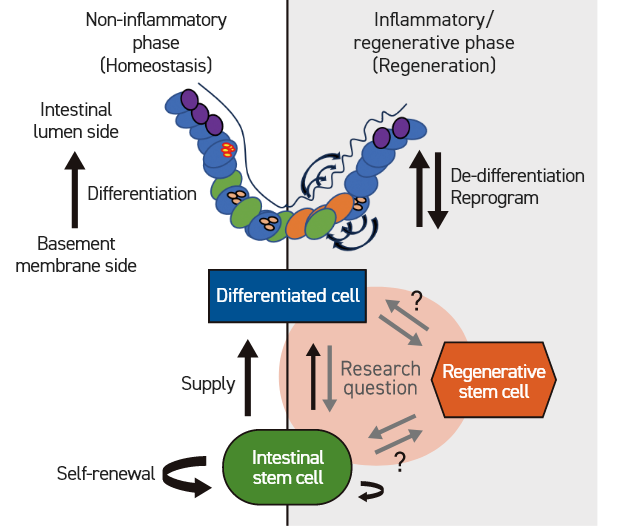
Intestinal stem cells self-renew while supplying differentiated cells. During the inflammatory phase, intestinal stem cells are damaged and self-renewal is impaired. Therefore, a mechanism is at work that attempts to de-differentiate differentiated cells and revert them to regenerative stem cells.
At the very bottom of the intestine are stem cells that have the ability to become a variety of cells, from which a variety of cells are supplied to the top. The cells supplied are slightly more differentiated than stem cells and have their own role in the gut. When inflammation occurs and stem cells become scarce or damaged and are unable to turn over, cells differentiated from stem cells rejuvenate and become more stem cell-like, filling in for the stem cells to complement regeneration. Recently in the medical industry, cells are being forced to express genes that make them younger and acquire various roles, as in the reprogramming of iPS cells by Professor Shinya Yamanaka of Kyoto University. This is artificially expressed, but the same mechanism of going in the opposite direction from differentiation is actually happening naturally in the body. However, we have only begun to understand that this phenomenon is present. We have not yet fully determined what pathology it involves and what cells are most important.
Our laboratory has traditionally been very advanced in 3D culture techniques for intestinal epithelium and is one of the best in the world. We are using mouse and human cell culture techniques to study the mechanisms of cell reprogramming and its involvement in pathological conditions.
When examining the condition of cells in culture, it has been common to make a medium on a flat surface and spread the cells on the medium. To investigate what is happening in something as three-dimensional as the intestinal epithelium, the culture itself must be reproduced in the shape of the intestinal epithelium. Therefore, they are cultured in mini-organ organoids, three-dimensional structures that mimic organs and tissues, with the reproduced shape of the intestinal epithelium. By doing so, we can create a culture condition that is similar to the real intestinal tract and investigate various conditions.
Specifically, what we are doing is reproducing diseased intestinal epithelium on organoids, dividing it into various cell types and coloring them, and then tracking each one and observing how it looks and changes, noting for example that "this cell behaves this way under these culture conditions" or "with this kind of inflammation, the progeny cells are around here."
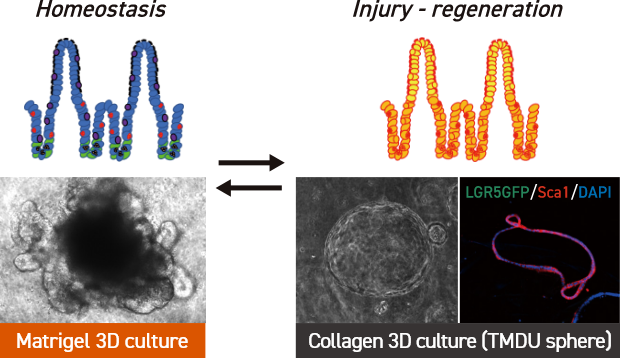
By utilizing organoid culture techniques from TMDU, the plasticity of inflammation and regeneration has been reproduced.
One of the techniques that is gaining so much momentum in biotechnology these days is single cell analysis. In the conventional analysis method, the area under examination was sampled in bulk, and the gene expressions were analyzed. Single cell analysis allows us to see the genes in each individual cell. It is now known that even cells classified as the same cell type or tissue have subtle differences in proteins and RNAs that result in different functions and properties being expressed. We can process the data on a computer and see what kind of cells are actually expressing what kind of genes by color coding, so we use such techniques to observe mouse and human cells.
Although there is not yet a large volume of data available, it is possible that both differentiated cells and original stem cells undergo a reprogramming phenomenon that complements regeneration when they become inflamed. I would like to continue my research from this vantage point.
- *
-
The process by which the information contained in a gene is converted into a form that is actually usable and functions within an organism.
Discussion
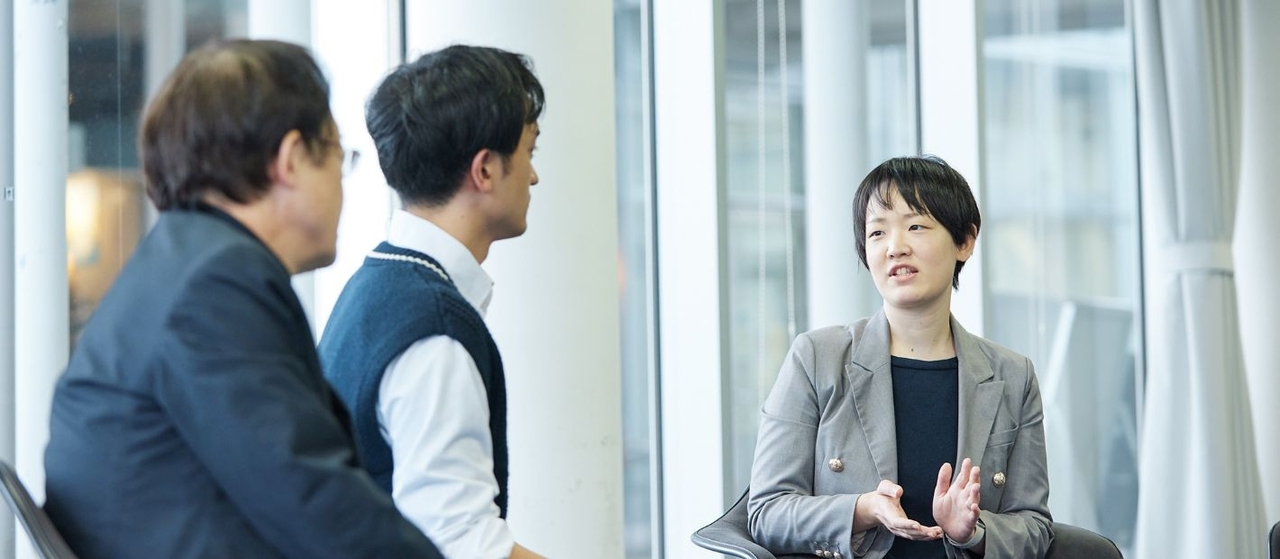
Yamazaki:Listening to what Ms. Kirino said earlier, I was surprised to learn that cells are regenerated at a very rapid rate in the intestines. I had wondered what the difference is between muscle inflammation and intestinal inflammation, and found it worth studying because of the rapid turnover.
Kirino:The intestinal tract is an organ with a fairly neatly constructed stem cell system, so it is easier to see the relationship to pathology than muscle. From a health professional's perspective, as a gastroenterologist, I have met quite a few ulcerative colitis patients, and I want to cure those people somehow. Being able to help people in need is the part of my research that I find most rewarding.
Yamazaki:I was also interested in the reprogramming of stem cells. Leaving aside iPS cells for the moment, could understanding the gut contribute in any way to the regeneration of artificial skin or retina?
Kirino:Our laboratory is also conducting clinical research on the use of organoids, so I believe that we can apply this technology to help people.
Masu:What size cells are visible in a single cell analysis?
Kirino:Depending on the cell type, about several tens of micrometers.
Masu:For example, if you have a line of cells several hundred micrometers across, you can observe and control the differences among them. In the world of materials engineering, too, analysis is nowadays conducted at the micrometer and nanometer level. The same is true of cryo-electron microscopy, which is now used for structural analysis and biotechnology. There is some overlap in terms of such analysis.
Kirino:Since this research is ever-evolving, there are many experiments that have not yet been performed in the laboratory, and it is not uncommon for me to start up new ones myself. For example, communicating with professors and researchers in computer science and other areas outside the laboratory was exactly what we needed to successfully carry out some experiments.
Dialogue: Curiosity leads to the highest peaks
Cutting edge research means networking is all the more important
Tanaka:What I felt was similar between the two of you was that you both felt that you needed to do something different from the conventional way of doing things, but you had no one to consult with. Because both of you are working at the cutting edge, there are few people to consult with.
Yamazaki:Indeed, there are not many laboratories in Japan working on high frequency integrated circuits. We are probably the most advanced laboratory in Japan in terms of high frequencies, so we are in a position where we have no choice but to pioneer a path forward on our own.
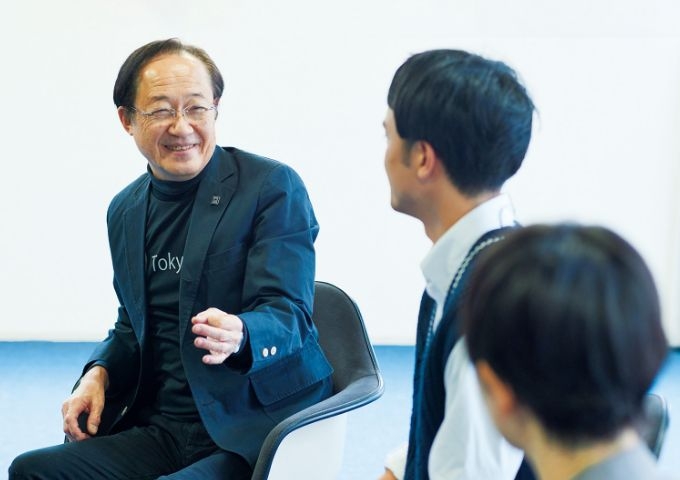
Masu:I'm sure there aren't many. But it's more than zero, so connections need to be made. Researchers need to create a network where they can discuss the deep issues. Professors naturally do this with one another, and we also have a network with researchers in other countries. It is really important to go out to various places, observe, and talk to people. It is surprisingly acceptable to jump directly into a conversation with a knowledgeable researcher. Those researchers are happy to hear from students. If you approach them yourself and tell them about your research, they will surely tell you that there is someone like this in their laboratory that you should meet.
Yamazaki:Yes, that's true. I think I will be proactive. In conducting my own research, my biggest concern is where to implement fast wireless devices. I talk to many different researchers, and they are all struggling with the question of where exactly to use faster wireless devices with both 5G and 6G. Of course, I will continue to study wireless device circuits in depth, but perhaps it is important for me now to dive into a field where I can make use of the technology and listen to what people have to say. Therefore, I believe that this merger of our universities will be an opportunity for networking. I hope that we can contribute in some way with wireless communication to specific applications in the medical field. If we discuss the situations with each other, we may find some issues and solutions using wireless communication.
Tanaka:There is a Building C at our university, where new operating rooms and intensive care units have been constructed, and it is truly a state-of-the-art environment in Japan. You cannot enter the operating room because it is sterile, but there is a 4K monitor. If you are a student at the university, you can see the entire operating room as well as the surgery, so please come by. I think you will gain some insights by actually seeing it. The medical field has problems, and I think it would be a very good thing if engineers could join in thinking about them. Medicine-engineering collaboration tends to be a matter of orders received and orders placed, but I think it is better to proceed with more interactions from the development stage, rather than doctors requesting a certain technology or engineers offering a certain technology they have created.
Working together on what we can, valuing everyone's curiosity
Yamazaki:It was interesting to hear about medical care in today's session, and I was very glad that President Tanaka told me to come see the operating room. I also realized how difficult it is to present my research to people in completely different fields, and how inadequate my explanations were. In that sense, I learned a lot.
Kirino:I also found today's discussion very interesting. I was impressed by Mr. Yamazaki's specific suggestion that his research could be applied in a certain way. I was also impressed by the fact that he said that their laboratory is one of the best in the world. I look forward to working with a university that has such cutting-edge laboratories. Since we've arrived at this point, I hope we can do something together.
Yamazaki:That sounds great. I hope to build a relationship where, in the course of our research, if we want to do fast wireless communication in the operating room, we can easily visit the operating room and have discussions together.
Kirino:I have long felt that TMDU is really looking forward to the merger with Tokyo Tech. In our researchers' social networking groups, there are frequent topics such as "What could be done through the merger with Tokyo Tech?" I was glad to learn today that Tokyo Tech's members are also looking forward to the merger.
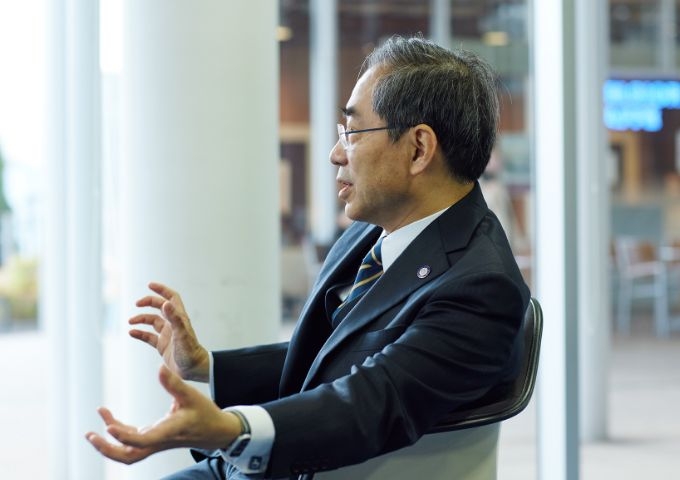
Tanaka:I would like to create more opportunities for us to mingle in this way. Since we are merging, there should be an incentive to intermingle. Although we have already tried a few things, I believe that we need a mechanism to provide research funding that transcends the boundaries between the undergraduate and graduate schools of the two universities.
Masu:I strongly agree. I also still want students to concentrate first of all on what they themselves want to do. You must have a standpoint that considers how to implement the results of your research in the real world, but it is also important to fully pursue what you yourself want to do before all that. I know because I did it myself, but I really enjoy researching integrated circuits. It is a joy to see how something that could not be done before can be done after designing something in a certain way. It is that kind of curiosity that allows us to reach a high level of excellence. I hope that while you are still aspiring researchers, you will focus on your research and enjoy it to the fullest. It is those of us who are in a position to provide guidance, such as myself, who need to think hard about real world implementation and how to make the most of technology.
Yamazaki:As you say, my fundamental desire is still to have fun making circuits. The next step is to figure out where I can make use of it.
Masu:They say that research should be directed at social issues so that it can contribute to society, but I would like you to first do curiosity driven research. That curiosity will surely create a path for you. I like to tell students, "The grass is always greener on the other side. Trust your own decisions and make your own way."
Tanaka:Both of those are definitely essential. I hope you will work hard towards your aspirations, just as our university will aspire to be the best in science and technology. Hold on to your dreams and let's pave the way together.
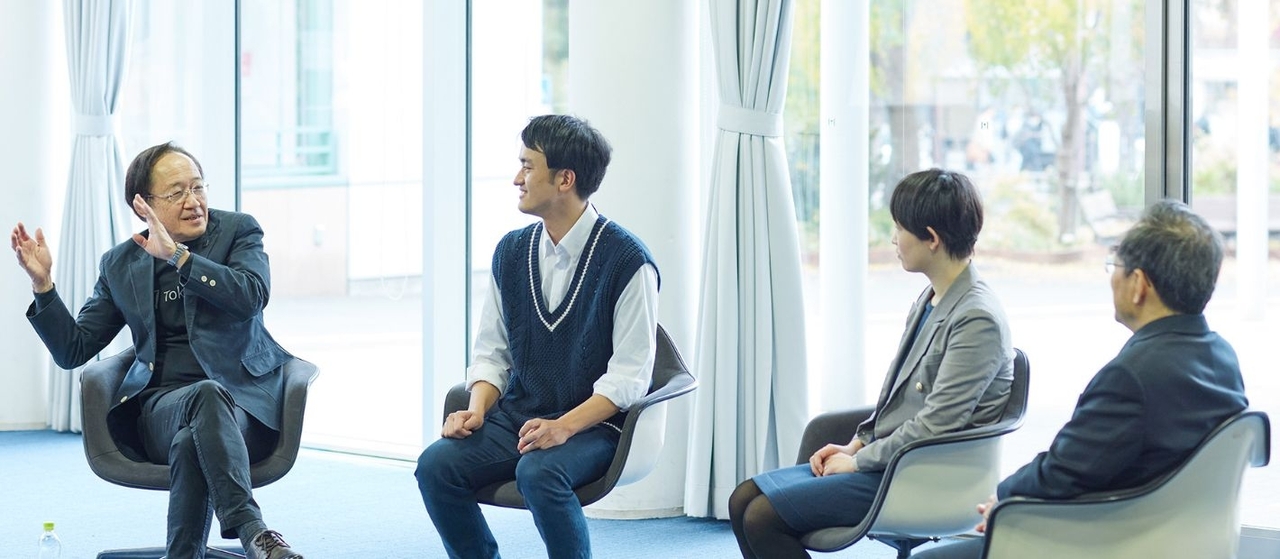
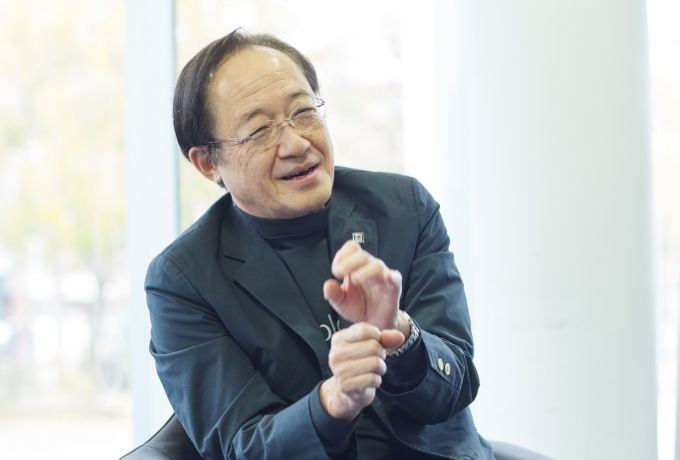
Kazuya Masu
President, Tokyo Institute of Technology
In 1982, he received a Doctor of Engineering degree from the Department of Electrical and Electronic Engineering, Graduate School of Science and Engineering, Tokyo Tech. In 2000, he became a professor at the Precision and Intelligence Laboratory. He assumed his current position in 2018. He specializes in semiconductor and integrated circuit engineering.
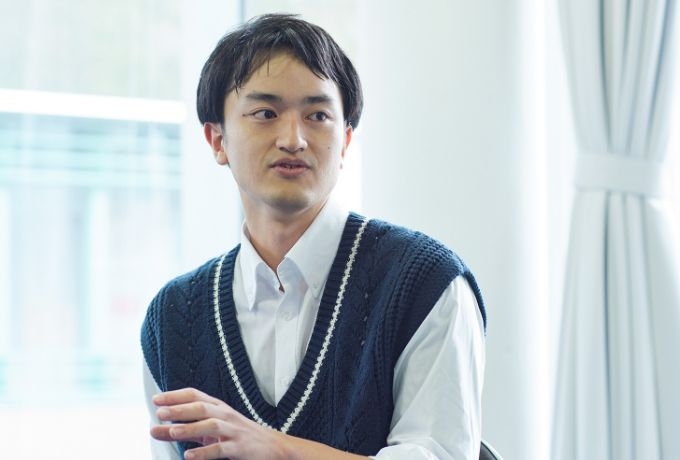
Yudai Yamazaki
1st year doctoral student, Department of Electrical and Electronic Engineering, School of Engineering, Tokyo Tech
Entered Tokyo Tech 5th Academic Group in 2017. Completed the master's degree program in Electrical and Electronic Engineering at the School of Engineering in 2023. Continued to the doctoral program, was selected for the Tokyo Tech Advanced Human Resource Development Fellowship for Doctoral Students, and received the 13th IEEE SSCS Japan Chapter VDEC Design Award.
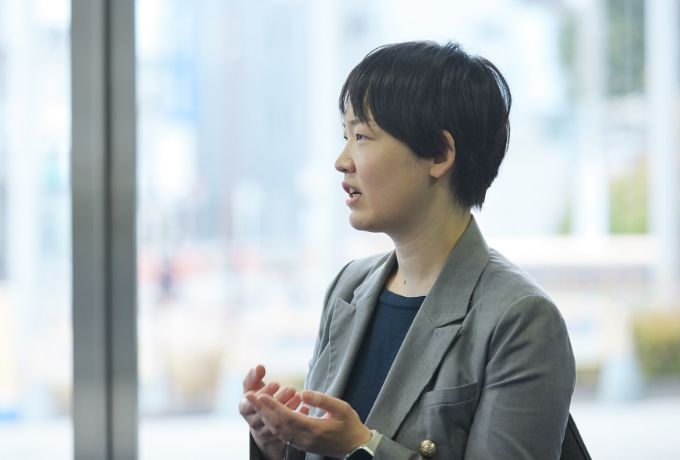
Sakura Kirino
2nd year of Doctoral Course, Gastroenterology, Graduate School of Medical and Dental Sciences, TMDU
Enrolled in the Department of Medicine, Faculty of Medicine, Tokyo Medical and Dental University in 2010. After completing her residency, she joined the Department of Gastroenterology in 2018. In 2022,entered the doctoral program in gastroenterology at the Graduate School of Medical and Dental Sciences. Accepted into the Clinician Scientist Program and TMDU Outstanding Graduate Student Program (II).
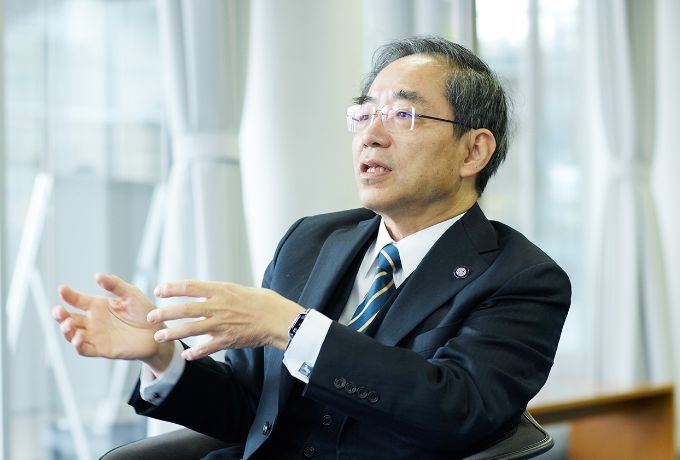
Yujiro Tanaka
President, Tokyo Medical and Dental University
In 1985, he completed the doctoral program at the Graduate School of Medicine, Tokyo Medical and Dental University. In 2001, he became a professor of the Department of General Medicine, Tokyo Medical and Dental University Medical Hospital. He assumed his current position in 2020. He specializes in gastroenterology and medical education.
The Special Topics component of the Tokyo Tech Website shines a spotlight on recent developments in research and education, achievements of its community members, and special events and news from the Institute.
Past features can be viewed in the Special Topics Gallery.
Interview held on December 11, 2023 at Tokyo Tech Kuramae Hall
. Any information published on this site will be valid in relation to Science Tokyo.
















